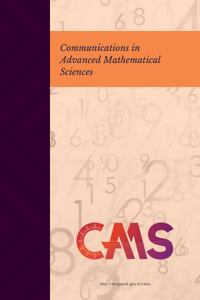An Agile Optimal Orthogonal Additive Randomized Response Model
An Agile Optimal Orthogonal Additive Randomized Response Model
In this paper, a new additive randomized response model has been proposed. The properties of the proposed model have been studied. It has been shown theoretically that the suggested additive model is better than the one envisaged by [1] under very realistic conditions. Numerical illustrations are also given in support of the present study.
Keywords:
Randomized response sampling, Estimation of mean Respondents protection, Sensitive quantitative variable,
___
- [1] S. Singh, Proposed optimal orthogonal new additive model (POONAM), Statist., LXX(1) (2010), 73–81.
- [2] S. L. Warner, Randomized response: A survey technique for eliminating evasive answer bias, J. Amer. Statist. Assoc., 60 (1965), 63-69.
- [3] S. K. Bar –Lev, E. Bobovitch, B. Boukai, A note on Randomized response models for quantitative data, Metrika, 60 (2004), 225-250.
- [4] J. A. Fox, P. E. Tracy, Randomized Response: A method of Sensitive Surveys, Newbury Park, CA: SEGE Publications 1986.
- [5] C. R. Gjestvang, S. Singh, A new randomized response model, J. Roy. Statist. Soc., 68 (2006), 523-530.
- [6] C. R. Gjestvang, S. Singh, An improved randomized response model: Estimation of mean, J. Appl. Statist., 36(12) (2009), 1361-1367.
- [7] N. S. Mangat, R. Singh, An alternative randomized procedure, Biometrika, 77 (1990), 439-442.
- [8] H. P. Singh, N. Mathur, Estimation of population mean when coefficient of variation is known using scrambled response technique, J. Statist. Plann. Infer., 131(1) (2005), 135-144.
- [9] H. P. Singh, T. A. Tarray, An alternative to Kim and Warde’s mixed randomized response technique, Statistica, 73(3) (2013), 379-402.
- [10] H. P. Singh, T. A. Tarray, An alternative to stratified Kim and Warde’s randomized response model using optimal (Neyman) allocation, Model Assist. Stat. Appl., 9 (2014), 37-62.
- [11] H. P. Singh, T. A. Tarray, A stratified Mangat and Singh’s optional randomized response model using proportional and optimal allocation, Statistica, 74(1) (2014),65-83.
- [12] H. P. Singh, T. A. Tarray, An improved randomized response additive model, Sri Lan. J. Appl. Statist., 15(2) (2014) ,131-138.
- [13] T. A. Tarray, H. P. Singh, Y. Zaizai, A stratified optional randomized response model, Socio. Meth. Res., 45 (2015), 1-15.
- [14] T. A. Tarray, H. P. Singh, An improved new additive model, Gazi Uni. J. Sci., 29(1) (2016), 159-165.
- [15] T. A. Tarray, H. P. Singh, Y. Zaizai, A dexterous optional randomized response model, Socio. Meth. Res., 46(3) (2017),565- 585.
- [16] T. A. Tarray, H. P. Singh, A simple way of improving the Bar–Lev, Bobovitch and Boukai Randomized response model, Kuwait J. Sci., 44(4) (2017), 83-90.
- [17] T. A. Tarray, H. P. Singh, A randomization device for estimating a rare sensitive attribute in stratified sampling using Poisson distribution, Afri. Mat., 29(3) (2018), 407-423.
- [18] T. A. Tarray, H.P. Singh, Missing data in clinical trials: stratified Singh and Grewal’s randomized response model using geometric distribution, Trends Bioinfor., 11(1) (2018), 63-69
- ISSN: 2651-4001
- Yayın Aralığı: Yılda 4 Sayı
- Başlangıç: 2018
- Yayıncı: Emrah Evren KARA
Sayıdaki Diğer Makaleler
Solution of Singular Integral Equations of the First Kind with Cauchy Kernel
Subhabrata MONDAL, B.n. MANDAL
Two Positive Solutions for a Fourth-Order Three-Point BVP with Sign-Changing Green's Function
Habib DJOURDEM, Slimane BENAİCHA, Noureddine BOUTERAA
A Unified Family of Generalized $q$-Hermite Apostol Type Polynomials and its Applications
Analytical and Solutions of Fourth Order Difference Equations
Marwa M. ALZUBAİDİ, Elsayed M. ELSAYED
On Signomial Constrained Optimal Control Problems
An Agile Optimal Orthogonal Additive Randomized Response Model
